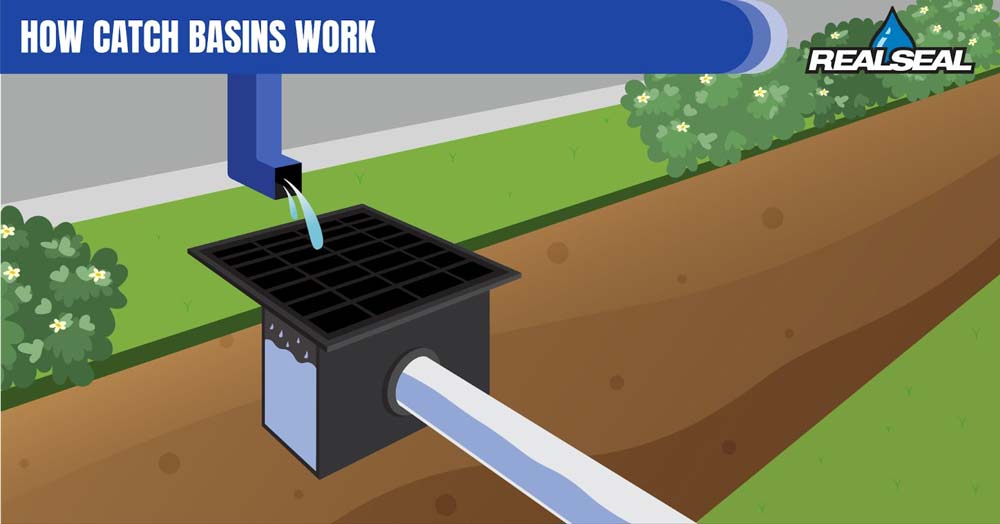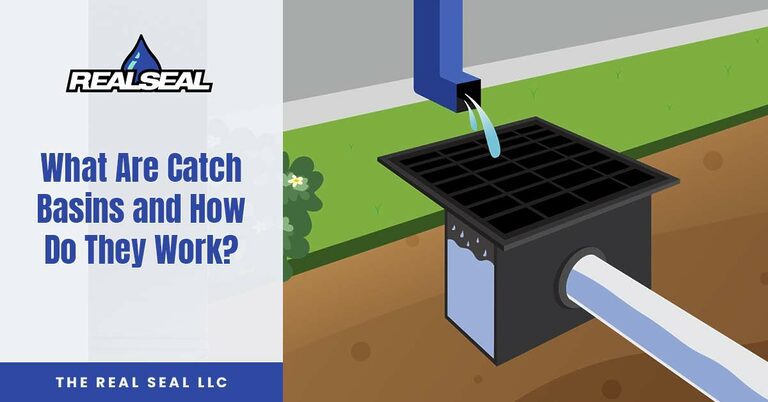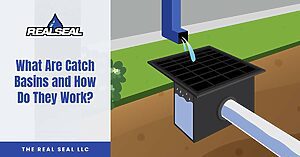Catch basins provide a way to disperse surface water runoff away from your home and out into designated areas, such as rivers and streams. In this blog post, you’ll learn about catch basins, how they work, their pros and cons, and more.
What Is a Catch Basin?
A catch basin is a receptacle beneath the ground that collects and redirects unwanted surface water from sidewalks, driveways, streets, etc. It allows water to flow through inlets or grates into an underground system of pipes, then channels it away from homes or low-lying areas that are prone to flooding.
Catch basins come in various shapes and sizes depending on their intended purpose, such as being built to cope with the heavy downpours of rain or collect debris and prevent it from entering the city drainage system.
Apart from preventing flooding and water damage, catch basins are vital in containing pollution and debris that would otherwise enter natural waterways, or even the municipal water system. This way, the catch basins help keep waterways clean and protect the environment, thus promoting a healthier ecosystem for all.
How Do Catch Basins Work?
The catch basins are situated at low points in a drainage system. Water flows into these structures through grated openings, and any sediment or debris that is too large to pass through the grates is trapped within the basin. Once inside the catch basin, the water is directed into a series of pipes that transport it to a stormwater management system. This can include retention ponds, wetlands, or other structures designed to slow the flow of water and allow it to be naturally filtered before it enters into local waterways.

One of the most significant benefits of catch basins is their ability to reduce the impact of stormwater runoff. By capturing sediment and debris, these structures help protect local waterways from pollutants and other contaminants that could harm aquatic life and create health hazards for nearby communities. Additionally, catch basins are a cost-effective solution to managing stormwater runoff, as they require minimal maintenance and can last many years with proper care.
Pros and Cons of Catch Basins
Pros
- Flood Prevention – One of the main benefits of catch basins is that they help prevent flooding. Catch basins collect water and redirect it to the drainage system, meaning water is less likely to accumulate and cause flooding. This is particularly important in urban areas where large amounts of water can cause significant damage to buildings and infrastructure.
- Improved Water Quality – Catch basins also help improve water quality by filtering out debris and pollutants before the water enters the drainage system. This means the water that eventually ends up in rivers and streams is cleaner and safer for people and wildlife alike.
- Reduced Maintenance Costs – Catch basins are relatively low maintenance, especially compared to other drainage systems. They can be cleaned, inspected, and repaired relatively easily, meaning they are often less expensive to maintain over the long term.
- Aesthetics and Safety – Catch basins can also improve an area’s overall aesthetics and safety. They prevent standing water on roads, sidewalks, and other public areas, which can be hazardous to pedestrians and vehicles. Additionally, they help maintain the cleanliness of parks, sidewalks, and other public spaces by preventing litter and debris from accumulating in these areas.
Cons
- Can Become Clogged – As catch basins collect debris and sediment over time, they can become clogged, reducing their capacity to capture stormwater runoff. This can lead to overflowing and flooding, damaging the surrounding property and infrastructure.
- Can Be a Hazard to Wildlife – As water collects in the basin, it can become a breeding ground for mosquitoes and other insects, posing a threat to local ecosystems. Small animals like frogs and turtles can also become trapped in catch basins and drown.
- Can Be Costly to Install – Depending on the size and location of the basin, excavation and construction costs can add up quickly.
Despite these drawbacks, catch basins remain valuable in managing stormwater runoff and protecting against flooding and environmental damage.
How Do I Know If I Need a Catch Basin?
Consider installing a catch basin if you’re experiencing frequent floods or pooling water on your property. Catch basins are designed to manage stormwater runoff effectively and prevent property damage caused by drainage issues. They’re especially useful for properties in areas that are prone to heavy rainfall or poor soil drainage.
If you’re unsure whether or not you need a catch basin, it’s best to consult with a professional. They can assess your property’s needs and help you determine the best solution for managing stormwater runoff. Don’t wait until a flood or water damage occurs; investing in a catch basin can save you time, money, and stress in the long run.
Is a Catch Basin the Same as a French Drain?
When it comes to managing stormwater, there are several options available. Two common solutions are catch basins and French drains – and while they are both useful for drainage purposes, they are not the same thing.
Catch Basins
A catch basin is a drainage inlet that collects and retains stormwater. Usually installed at low points in the pavement, they catch surface water runoff and feed the flow into storm sewer systems to prevent flooding. This type of drainage system is designed to trap debris and prevent it from flowing downstream, resulting in less water pollution. Catch basins are typically made from concrete or polymer materials and come in different sizes.
French Drains
A French drain is a trench that is dug into the ground and filled with gravel or rock that redirects water to another location. Its purpose is to prevent water from pooling up in certain areas and causing erosion or flooding. Water enters the trench through the gravel and is transported away from the drained area via a pipe or another drainage channel. French drains are commonly used in areas where water accumulates.
Is One Catch Basin Enough?
Whether or not one catch basin is enough depends on various site-specific conditions, and requires thorough analysis and planning. A one-size-fits-all approach isn’t sufficient to prevent the negative impacts of stormwater runoff.
Cleaning Catch Basins
Like all infrastructure, catch basins must be properly maintained to function effectively. One of the most important aspects of catch basin maintenance is cleaning because catch basins can become clogged with debris over time, particularly during periods of heavy precipitation. This debris can include leaves, twigs, rocks, and other solid materials. If left unchecked, the debris can obstruct the water flow and cause flooding. Therefore, regular cleaning is vital to keeping catch basins functioning correctly.
In addition to regular cleaning, catch basins may require more intensive maintenance from time to time, such as repairs or installation of new components.
If you’re in Chicagoland and thinking about installing a catch basin on your property or are concerned about an existing one, contact The Real Seal today to schedule a free consultation.







12 Responses
I drilled holes in my catch basin, will the water left over in the basin that leeches out affect my foundation ?
Hi Pedro,
As long as your catch basin is at least 15 feet from the house, it shouldn’t affect your foundation.
This post was really informative! I never realized how essential catch basins are in managing stormwater. It’s fascinating to learn how they help prevent flooding and protect our water quality. Thanks for shedding light on this important aspect of infrastructure!
Glad you enjoyed it!
Great explanation of catch basins! I appreciated how you broke down their function and importance in managing stormwater. It’s fascinating to see how something so simple can play a crucial role in preventing flooding and protecting our waterways. Thanks for sharing this valuable information!
Happy to help!
This post really clarifies the function of catch basins and their importance in stormwater management. I had no idea they played such a crucial role in preventing flooding and protecting our water quality. Thanks for breaking it down so clearly!
Happy to have helped!
Thanks for explaining catch basins so clearly! I never realized how crucial they are for managing stormwater. It’s interesting to see the role they play in preventing flooding. I’ll definitely look out for them the next time I’m out!
Happy to have helped!
Great explanation! I never realized how essential catch basins are for managing stormwater. It’s fascinating to learn how they help prevent flooding and keep our water systems more efficient. Thanks for sharing this information!
You’re very welcome!